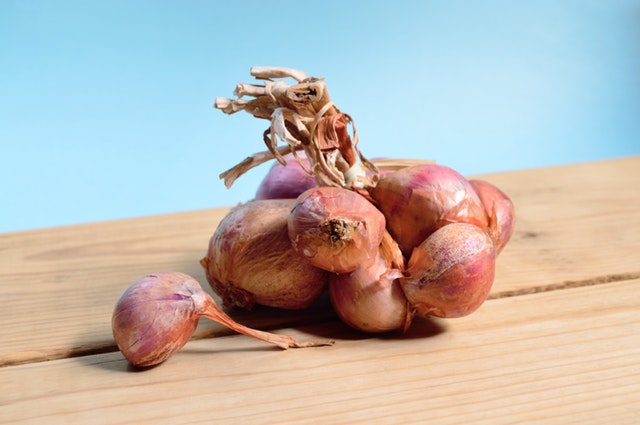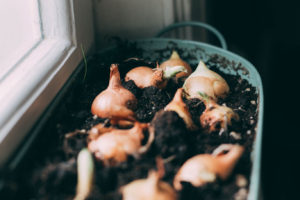Asking yourself “Why are my onions dying?” over and over again while miserably hovering above your plants will get you nowhere.
But I get it. It’s easy to lose track of your plants especially when you’re new to gardening. Even more so when you don’t know what exactly to expect while your onions grow and mature. One day, you’ll see something that just feels off and you’ll catch yourself stressing over it.
So you panic. And you have a good reason to. Troubleshooting should be done as soon as possible if you want your onion plants healthy and thriving again.
Now calm down and look at your onion plant. Look at it closely. Because unfortunately for us, gardeners, plants can’t just explicitly tell us what’s wrong with them. We have to check them out ourselves.
What do you see? Wilting leaves? Rotten tops? Your guess might just be right, your onion plants may be dying.
But don’t worry! I’ve compiled a neat list of tell-tale signs you should look out for to know what’s really happening with your onions.
Below you’ll learn just why you’re onion plants are dying. And they can range from simple plant care mishaps to annoying pests problems.
Let’s start saving your precious onion plants.
Wrong Planting Time
What to look out for
The onion plant is leafy but it doesn’t produce any bulbs.
What to do
Make sure to plant your onions at the correct time. Onion is a cool-season crop that is best planted in spring (Feb to April) or late autumn. It can be planted as early as 4 weeks before the first local frost-free days.
About 1 to 2 months before planting outdoors, the ideal temperature for onions ranges from 32°F to 50°F. Once planted outdoors, the temperatures shouldn’t go below 20°F (-6°C).
If you planted your onions at the wrong time, chances are, the temperatures are too warm for it to thrive so it’s best to just start over again. Plant the right cultivar at the proper time.
Water Stress due to Overwatering
What to look out for
The onion tops start dying back.
What to do
Immediately cut back on watering. Overwatering your plants may lead to rotten bulbs and eventually to failed crops.
For ground-grown onions, consistent even watering is needed. Just about one inch of water per week is going to be sufficient (this includes rainwater). Onions grown in pots will need at least 2 to 3 inches of water per week.
Uneven Watering
What to look out for
The emerging onion bulbs appear to have been split into 2 to 3 sections.
What to do
Continuous uneven watering will harm your plant. Make sure to water your plants evenly and allow the soil to dry at least 4 inches deep before watering the plants again. To aid in moisture retention, add mulch. 7 weeks prior to harvest, stop feeding your onion plants.
Give 1 inch of water per week for ground-grown onions (including rainwater) and 2 to 3 inches of water per week for onions grown in pots.
Phosphorus or Potassium Deficiency
What to look out for
Stunted plant growth and relatively thick onion necks.
What to do
In this case, your onion plants won’t necessarily die but they will eventually stop growing. So it’s best to side-dress your plants with aged compost. You can also spray the plants with kelp or compost tea. Doing so will also boost your plant’s growth.
Pests –Onion maggots
What to look out for
Onion leaves are fading, wilting and yellowing. The leaf tips are turning brown. If you check the bulb, you should see tunnels and cavities forming. Additionally, there are likely eggs to be found at the base of the plants.
What to do
This pest is a white legless larva of an adult fly that likes to lay their eggs at the base of the plants. Prevent this by covering your emerging onion bulbs with a fine mesh netting. Seal around the edges by mounding it with soil.
If pests are seen, immediately destroy them.
Keep your garden clean and pick out the decaying organic matter as they attract these insects. You can expect Onion maggots during very rainy periods, so you can disregard these suggestions during dry seasons.
Remember to completely harvest your onions as the season progresses.
Pests – Onion Thrips
What to look out for
Thrips are tiny insects that can attack your plant. They look as fat as a sewing needle. They are very tiny so in order to check if they’re around your crops, knock a dark piece of paper against onion tops. They will appear as tan-colored bodies on the paper.
What to do
Carefully follow the package directions of your insecticidal soap spray and they will disappear after a couple of treatments. Always keep your garden clean. If pests are seen, you can also spray or blast them away with water.
You may also opt to place several sticky traps near your onions. There are various colors available, see what works best for you.
Pests – Leafminers
What to look out for
Check leaves for thin, white winding trails. There may also be white blotches on leaves if highly infected (heavy mining). There are leaves dropping from the plant prematurely. Reduced yield due to early infestation.
The pest itself looks like a small black and yellow fly. Leafminers will lay their eggs in the leaf and the larvae will then hatch and feed on the leaf interior, slowly destroying your onion plant.
What to do
Immediately check your onion transplants for any signs of leafminer damage (as mentioned above) before transferring them onto their final location. And make sure you remove plants from the ground right after harvest.
If infected, it is highly important that you only use insecticides when leafminer damage has been identified. You don’t want to spray if you’re not sure they’re present since that will only reduce the population of their natural enemies thus helping the pests and not your plants.
Diseases –Downy mildew
What to look out for
You can spot this disease when you observe yellow or white spots on leaf surfaces and patches of mold on the underside. Often, stalks will wilt, bend and eventually die.
What to do
This is a fungus that favors cool wet humid conditions. Avoid Downy mildew by planting resistant cultivars. Make sure you keep the soil well-drained and remember to allow the ground to dry between waterings.
Always keep your garden clean. Remove plant debris and take note that your plants are receiving enough air circulation.
If infected, prevent spreading by removing the affected leaves and stems.
Diseases –Onion neck rot
What to look out for
Onion neck rot appears as a grey-colored fluffy fungus growing on the head of the onion that into a black fungus after some time.
What to do
This is arguably one of the most common onion diseases you will ever encounter. It is caused by the fungus Botrytis allii, and all onion varieties can be affected by it. You can usually expect this just after the harvest.
Do not plant your onions in the same spot every year consecutively in order to avoid this. Plant other crops instead. I also suggest drying the newly harvested onions at warm temperatures in an area with good ventilation.
Diseases – Fusarium damping-off
What to look out for
Rotten seeds covered in molds, root tips appearing to be discolored (may be red or black, pink, yellow or tan) and seedlings that grow super slow which will then wilt and die.
What to do
This is caused by a certain fungus that survives in soil. The best way to prevent this is by only planting good quality seeds taken from a reliable source. This is to assure that your plant will grow from a disease-free seed.
If infected, treat the plant with fungicide. Carefully follow the instructions from the packet and apply proper amounts at the proper time. You can also opt to try a steam treatment or fumigation of soil. Doing either of these will help in reducing the levels of Fusarium in the soil.
Crop rotation is also advised in order to reduce the pathogen in the soil in your garden.
Diseases – Pink root
What to look out for
Check if roots are light pink in color, it will typically darken then turn purple. These roots may also become transparent and water soaked. Seedling of infected plants also dies. Overall your plant will look weak as if it has a nutrient deficiency.
Another sign that your onion plant is infected is when it is stunted and only produces undersized and shriveled bulbs.
What to do
Do not plant onions in the same area continuously or plant them or in a 1-year rotation. That is where the disease will be most severe. The ideal rotation is 3-6 years. Another way to avoid this disease is by planting resistant varieties that will work in your climate.
Solarization, as well as fumigation, are advised practices that can aid in reducing the levels of pathogen in the soil.
I would love hearing from you in the comments sections below if you had a problem with your onions i didn’t cover.



